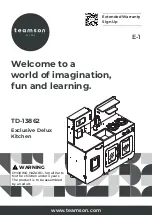
4
Informationen zum Vorbild:
Aufgrund der guten Erfahrungen mit den Baureihen
E 04 und E 17 hatte die AEG im Jahre 1933 den Auftrag
zur Entwicklung einer Lokomotive für den schweren
Schnellzugdienst erhalten. Zur Kraftübertragung auf die
Treibräder bevorzugte die AEG wiederum den seit Jahren
erfolgreichen Federtopfantrieb. Die Lauf- und die
benachbarte Treibachse wurden im AEG-Krauss-
Helmholtz-Gestell gelagert.
Die Lokomotive erwies sich mit ihrer Leistung von
2800 kW und einer Höchstgeschwindigkeit von 150 km/h
als überaus leistungsfähig.
Als stärkste Einrahmenlokomotive erhielt die E 18 auf der
Pariser Weltausstellung 1937 den Grand Prix.
Vor 1945 wurden 53 Maschinen in Dienst gestellt, nach
dem Krieg kamen noch 2 weitere dazu.
Die E 18 war nach 1945 mit 41 Stück in Westdeutschland,
6 Stück in der DDR und 2 in Österreich vertreten. Die
restlichen 6 Stück gingen im Krieg verloren.
Die E18 42 war noch einige Jahre die schnellste Lok der
BBÖ (Bundesbahnen Österreichs). 1952 erhielt sie die
attraktive Farbgebung in 2 Grüntönen; in diesem Zustand
zeigt sich das vorliegende Modell. Nach Gründung der
ÖBB wurde die E 18 42 modernisiert, umbenannt in
1118.01 und später in die blutorange „Jaffa“-Farbgebung
umlackiert, die sie bis zu ihrer Ausmusterung im Jahr
1985 behielt.
Information about the Prototype:
In 1933 AEG was given the contract for the development
of a locomotive for heavy express service, based on the
good experience with the classes E 04 and E 17. AEG
once again preferred the successful quill drive for trans-
mitting power to the driving wheels. The pilot axle and the
nearest driving axle were mounted in the AEG-Krauss-
Helmholtz frame.
This locomotive was quite powerful with its output of
2,800 kilowatts / 3,754 horsepower and a maximum
speed of 150 km/h / 94 mph.
The E 18 was awarded the Grand Prix at the Paris World
Exposition in 1937 as the most powerful single-frame
locomotive.
Fifty three units were placed into service before 1945; 2
more were added after the war. After 1945 there were 41
units of the E 18 in West Germany, 6 units in East Germa-
ny, and 2 units in Austria. The remaining 6 units were lost
in the war.
Road number E18 42 was the fastest locomotive on the
BBÖ (Federal Railways of Austria) for several years. In
1952, it was painted in an attractive 2-tone green sche-
me; the model before you is in this color scheme. Road
number E 18 42 was updated after the establishment of
the ÖBB (Austrian Federal Railways), re-classed as road
number 1118.01 and later repainted in the reddish orange
„Jaffa“ paint scheme, which it kept until being retired in
1985.





































